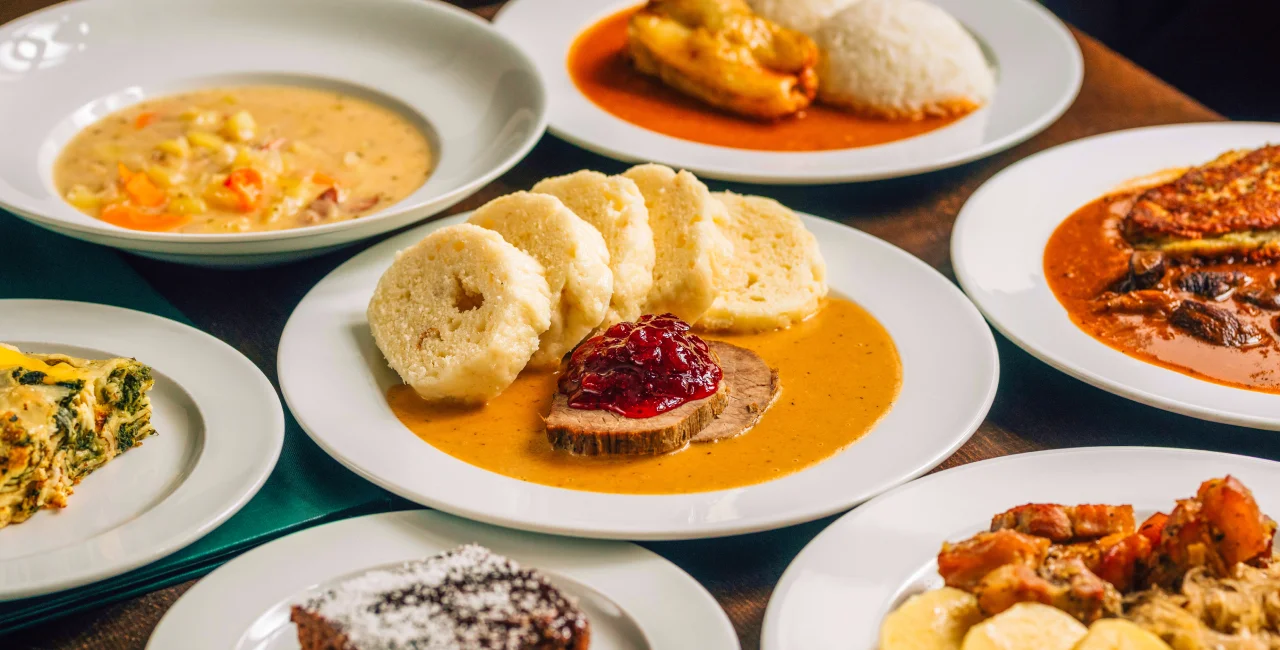When you think of traditional Czech cuisine, the one dish that instantly comes to mind is beef sirloin in a cream sauce (svíčková na smetaně) served with soft bread dumplings (houskový knedlík). While it’s a staple in pubs across the country, making this hearty and comforting dish at home is a perfect way to welcome the brisk fall weather.
Named after the cut of beef traditionally used—svíčka, or tenderloin—this dish has evolved over time. “Historically, there wasn’t always enough tenderloin to go around, so home cooks turned to alternatives like round steak or falešná svíčková (false tenderloin), which has more collagen and gives the sauce a deeper flavor,” says František Kšána, butcher at Naše Maso. Nowadays, it’s commonly prepared with various cuts like a top round or sirloin.
Want to give it a try? This recipe is adapted from the chefs at Prague pub Lokál U Bílé Kuželky.
Svíčková na smetaně from Lokál
ingredients
- 100 g (3.5 oz) salo, in Czech špek, cut into strips (see note)
- 2½ kg (5.5 lbs) beef round or top sirloin
- 1 kg (2.2 lbs) carrots, diced
- 500 g (1.1 lbs) celery root, diced
- 500 g (1.1 lbs) parsnips, diced
- 1 kg (2.2 lbs) onions, finely chopped
- 1 large lemon, sliced
- 175 g (6 oz) lard
- 125 g (4.4 oz) mustard
- 200 ml (¾ cup) vinegar
- 2–3 liters (8–12 cups) beef broth
- 750 ml (3 cups) heavy cream (31%)
- 5 juniper berries
- 10 peppercorns
- 10 allspice berries
- 10 bay leaves
- 200 g (1 cup) sugar
- 1 tsp dried thyme
- Salt and freshly ground pepper
- 100 g (3.5 oz) butter, 100 g (3.5 oz) flour, for the roux
- Bread dumplings (Carlsbad variety are best!), cranberry sauce, and whipped cream, to serve
CHEF'S NOTES: Salo, or slanina, is made from salt-cured pork fat, with or without skin or layers of meat. Popular across Central, Eastern, and Southeastern Europe, it can be dry salt or brine-cured, sometimes with seasonings like paprika. Unlike bacon, it contains more fat than meat; unlike lard, it isn’t rendered. It's similar to Italian lardo but differs in preparation methods.
instructions
- 1.Prepare the bacon: Cut the bacon into 10 cm (4-inch) strips, about as thick as a pinky finger. Lay them on a tray and freeze them for one hour to firm them up, making them easier to insert into the beef.
- 2.Stud the beef: Pierce holes into the meat using a sharp knife and insert the bacon strips. Season the beef generously with salt and pepper.
- 3.Brown the beef: Heat the lard in a large, heavy-bottomed pot over medium-high heat. Sear the beef on all sides until golden brown. Remove the meat and set it aside.
- 4.Sauté the vegetables: Lower the heat to medium, then add the carrots, celery root, parsnips, and onions to the pot. Cook until the vegetables caramelize, then stir in the mustard and vinegar. Simmer for 5 minutes, allowing the vinegar to evaporate.
- 5.Simmer the sauce: Add enough beef broth to cover the vegetables. Pour in 250 ml (1 cup) of the cream and add the sugar, thyme, and lemon slices. Wrap the spices (juniper berries, peppercorns, allspice, and bay leaves) in cheesecloth and place them in the pot. Return the beef to the pot, cover, and simmer gently for 2 to 3 hours until the meat is tender.
- 6.Make the roux: Melt the butter in a small saucepan and whisk in the flour. Cook until it turns light brown, then remove from heat and let it cool.
- 7.Finish the sauce: Once the beef is tender, remove it from the pot and set aside, keeping it warm. Discard the cheesecloth with the spices, and puree the vegetables and liquid until smooth. Stir in the remaining broth and bring the sauce to a boil. Gradually whisk in the roux and cook until the sauce thickens. Add the rest of the cream just to warm it, but don’t let it boil, as the cream could curdle.
- 8.Season and serve: Taste the sauce and adjust the seasoning with salt, sugar, or a splash of vinegar as needed. Slice the beef, pour the velvety sauce over the top, and serve with dumplings, cranberry sauce, and whipped cream.
In the Czech Kitchen is a weekly column in cooperation with Ambiente’s culinary experts. Established in 1995, the Prague-based collective of pubs, restaurants, and fine-dining outlets has transformed the Czech culinary landscape and contributed to the widespread awareness of quality food service and production in Czechia. Follow their socials or book your table at www.ambi.cz.












 Reading time: 3 minutes
Reading time: 3 minutes 

















